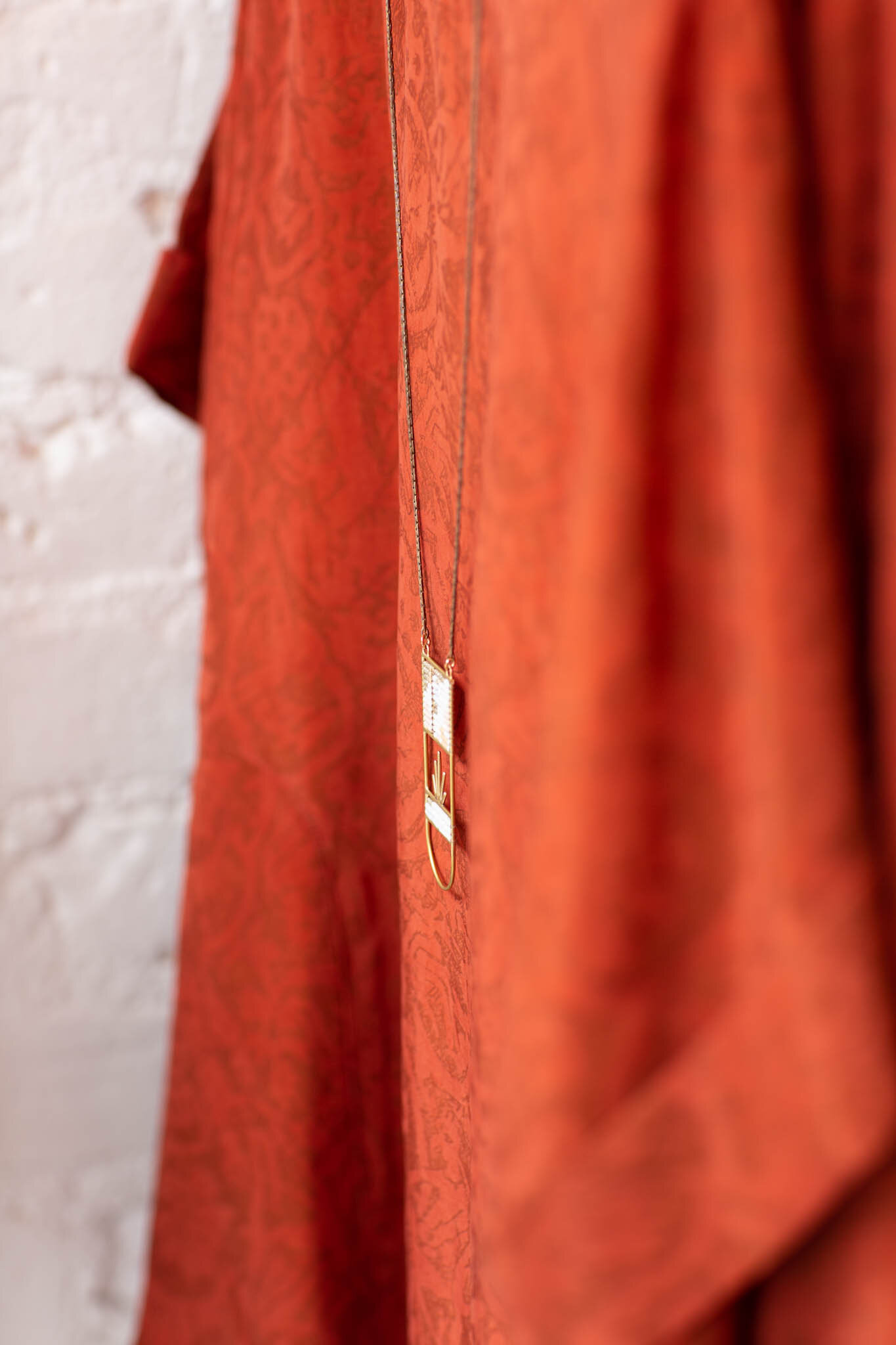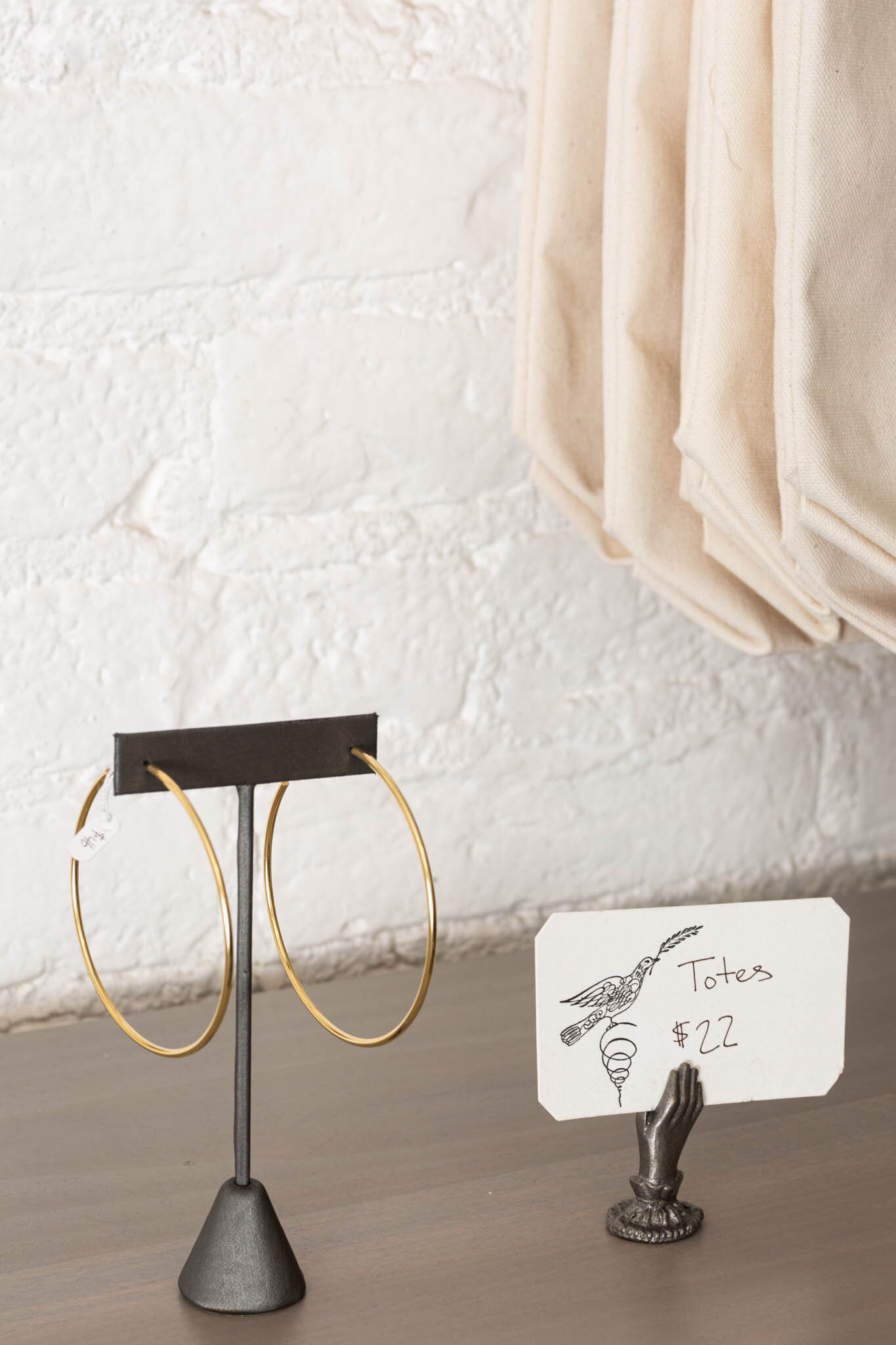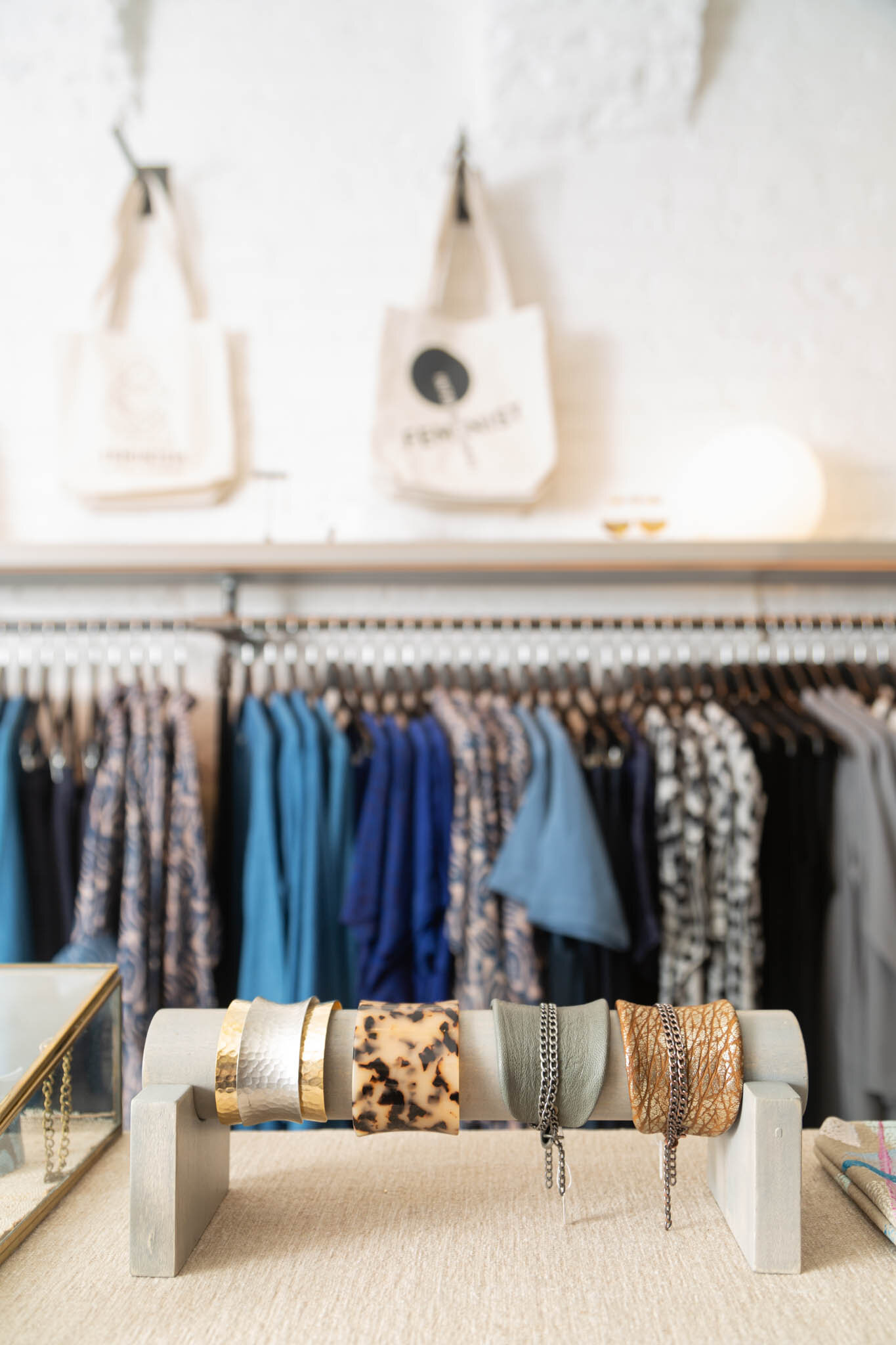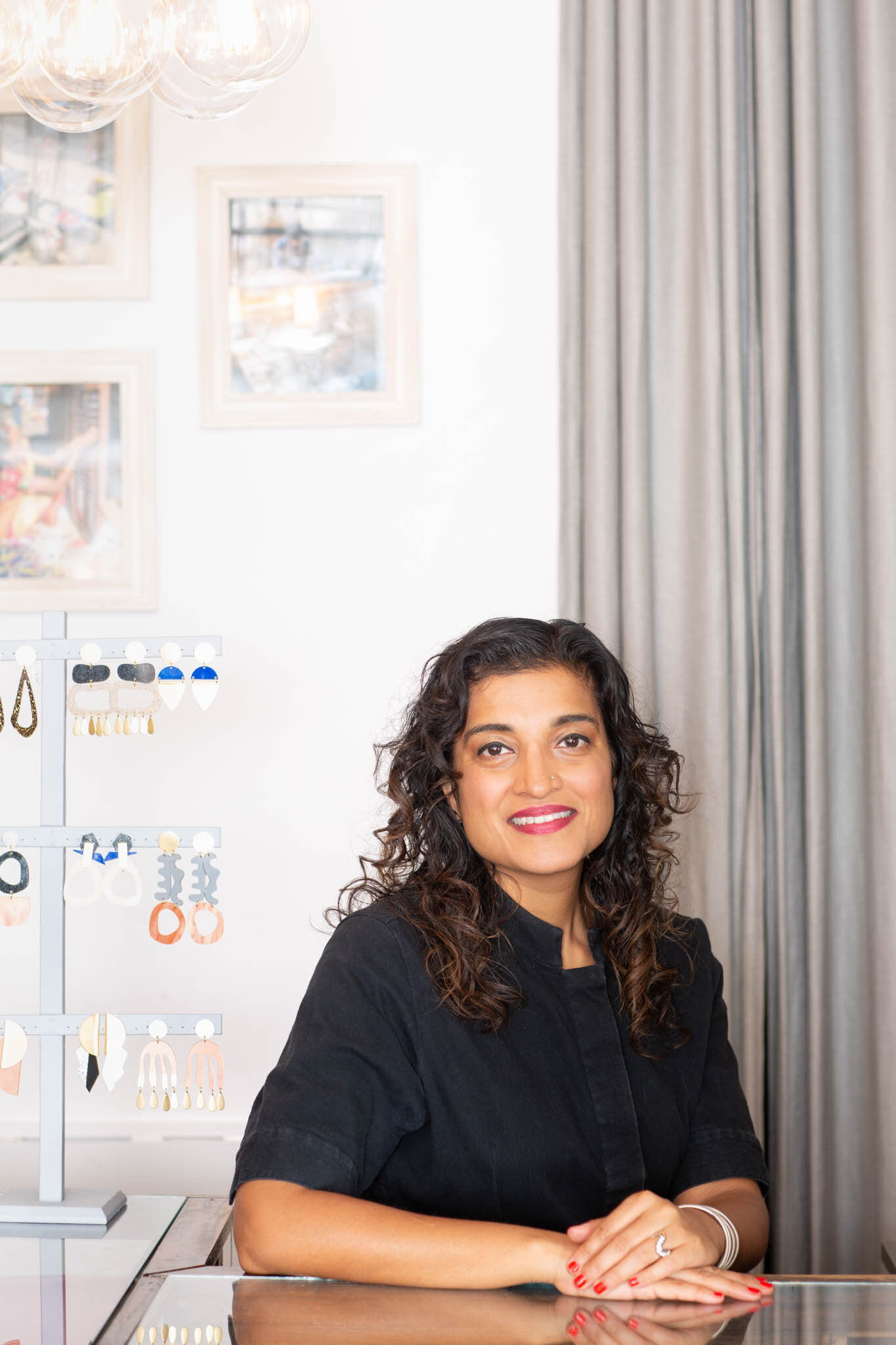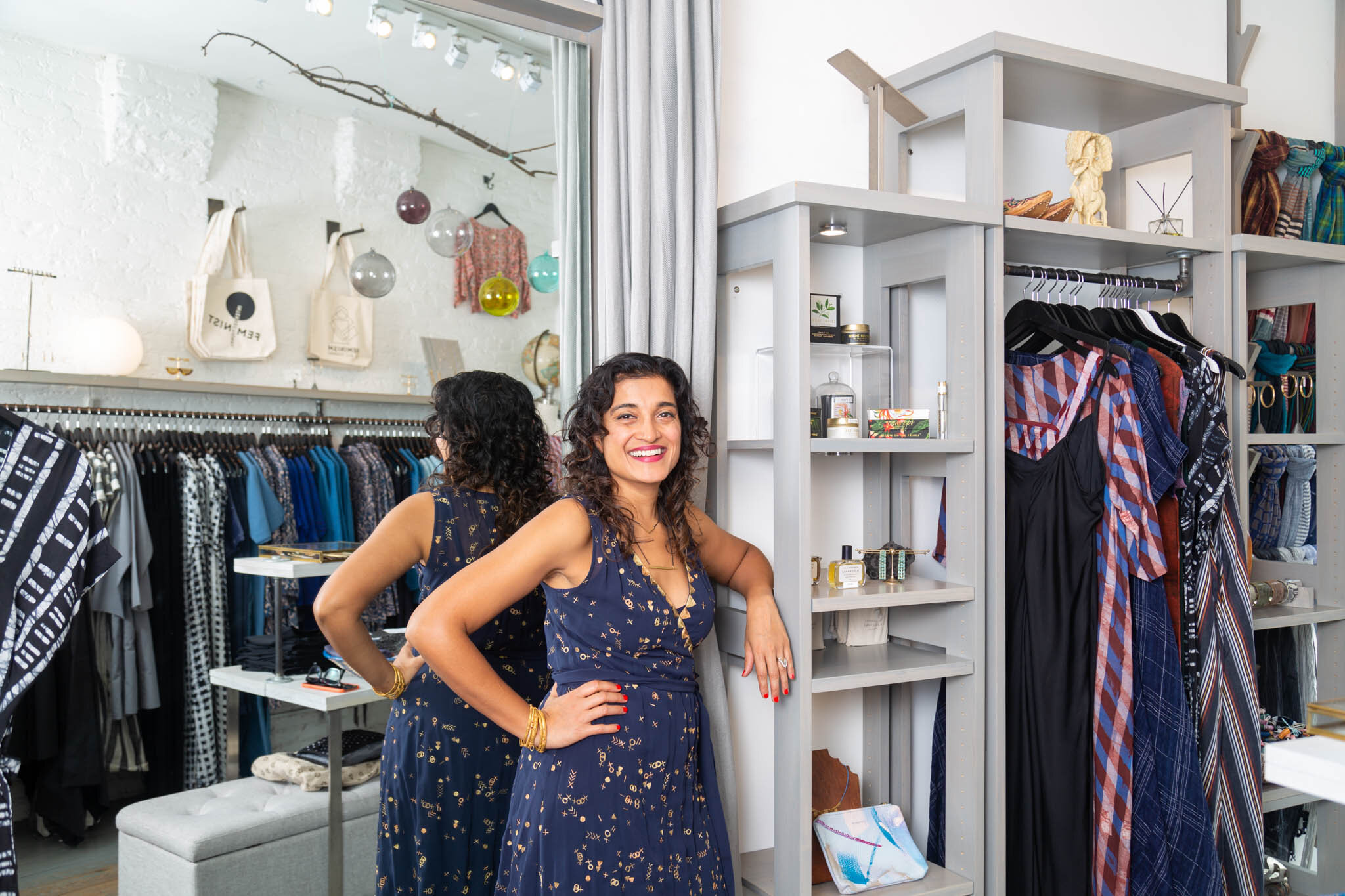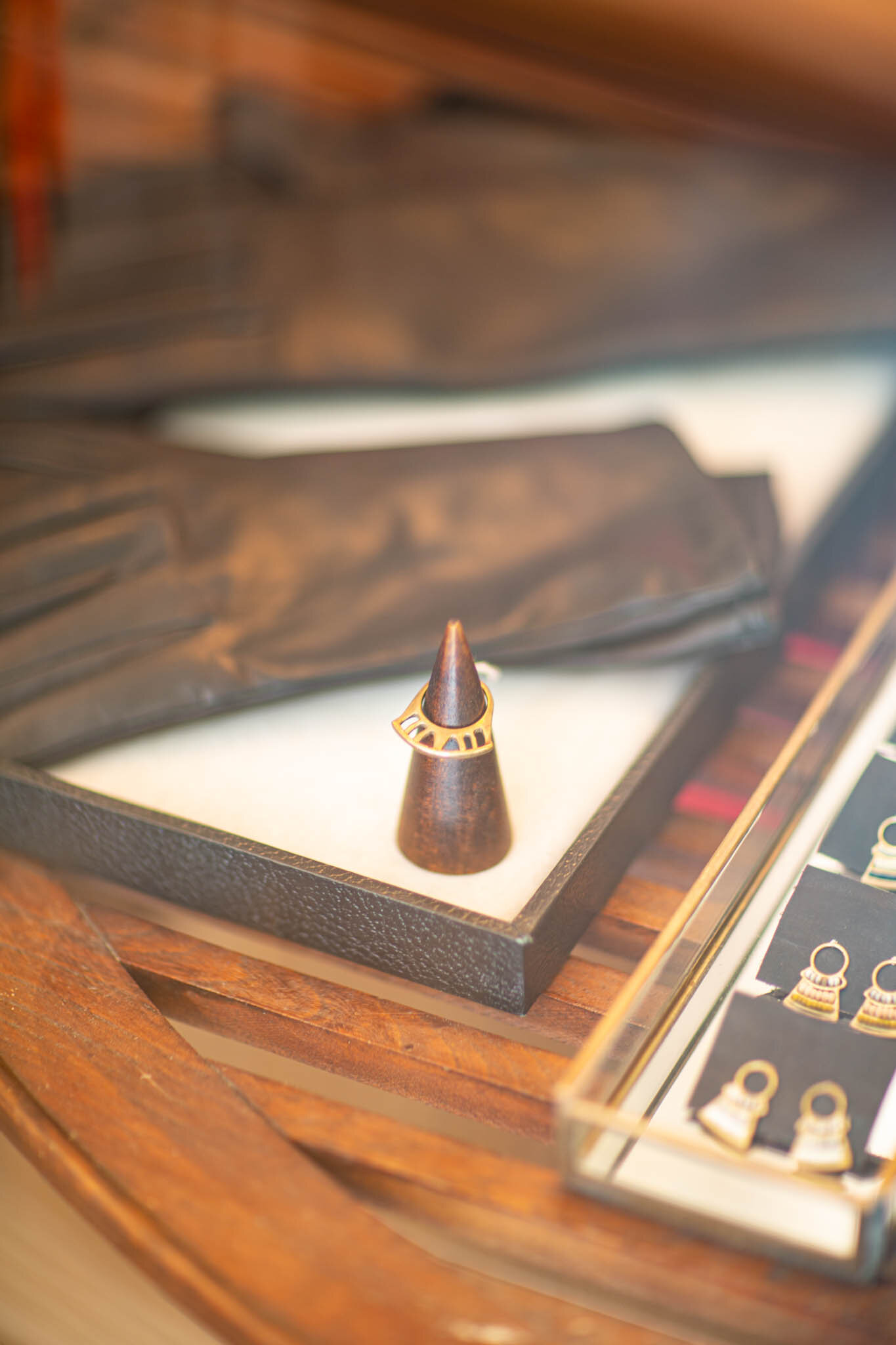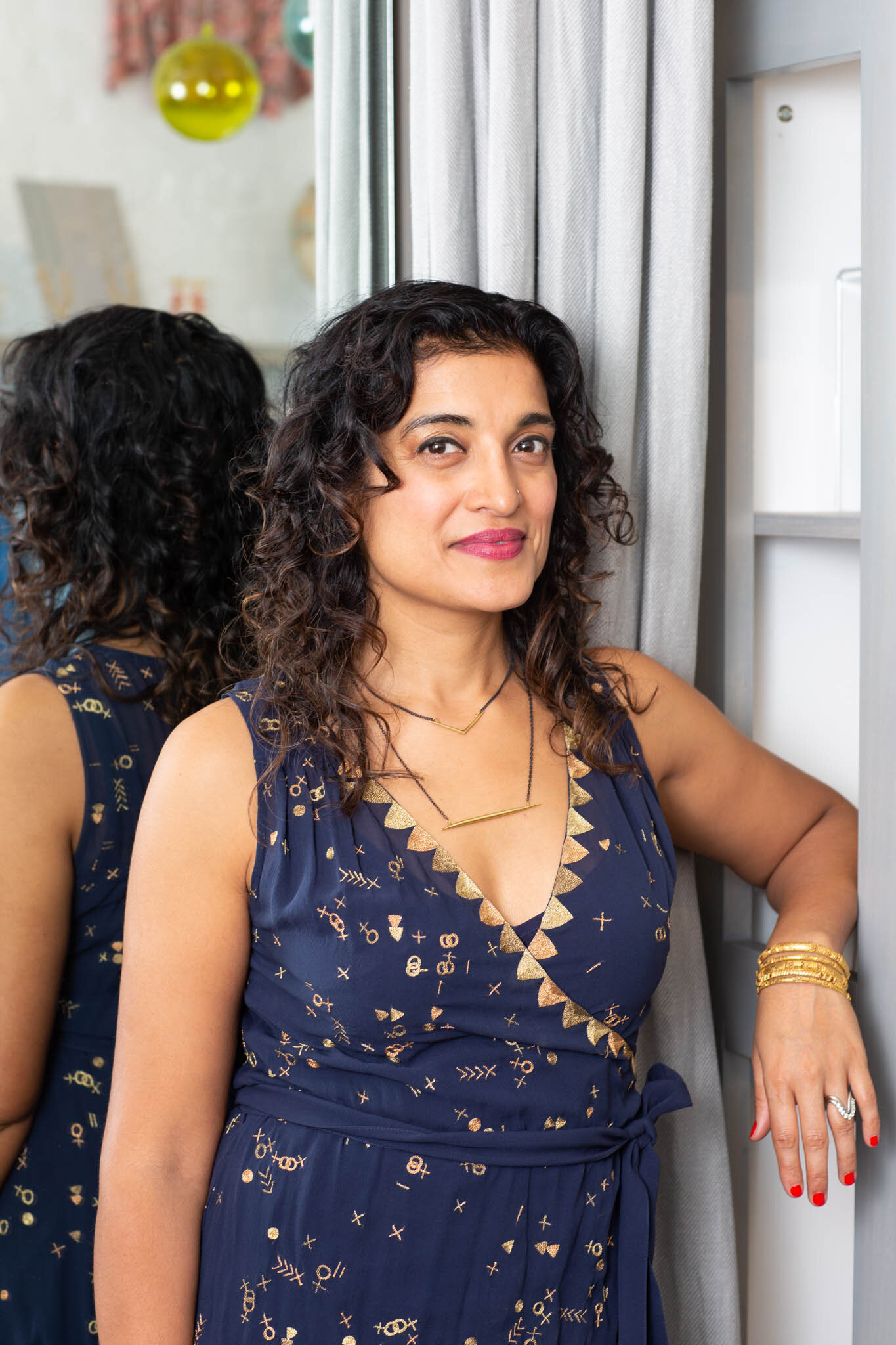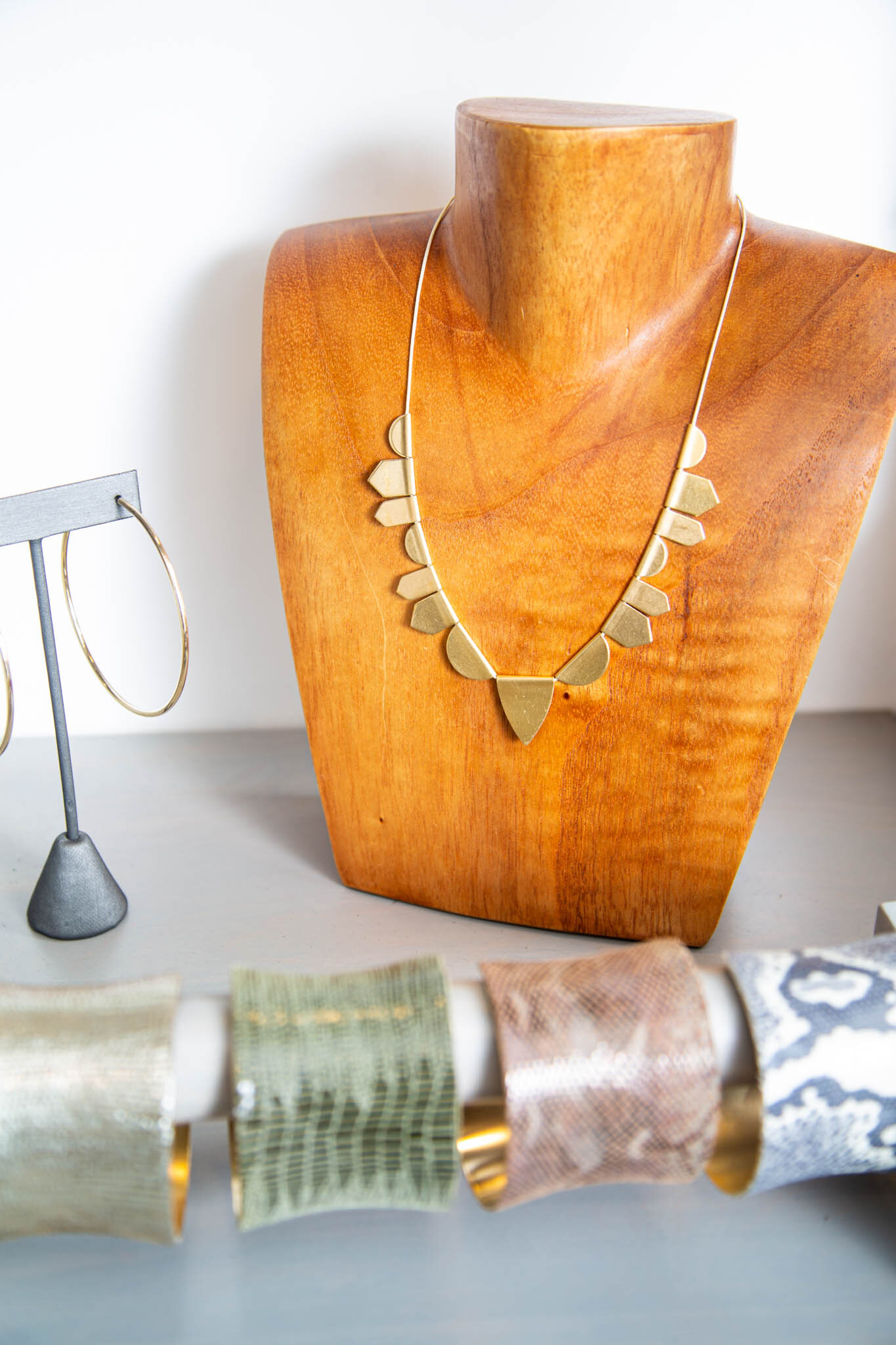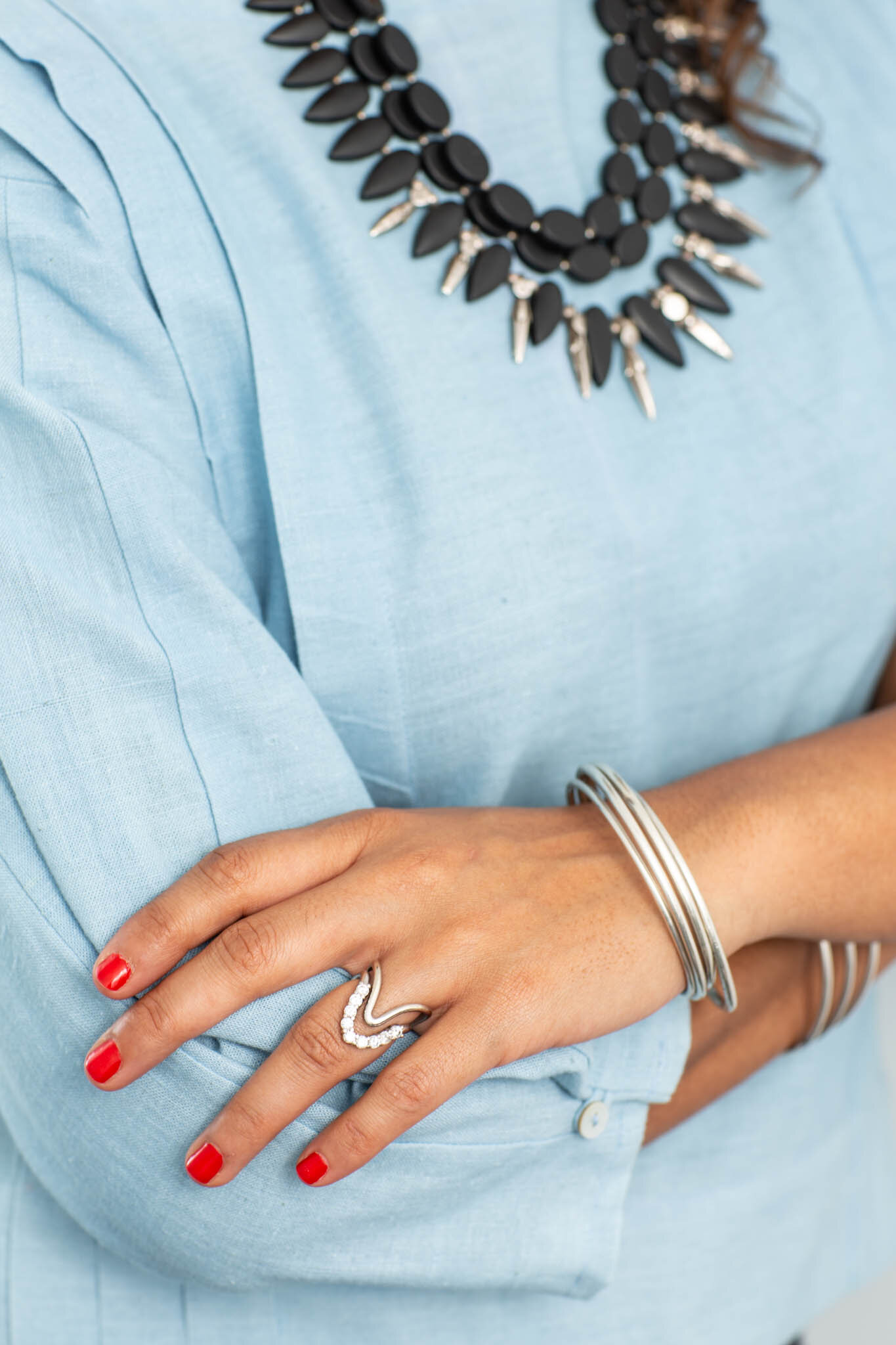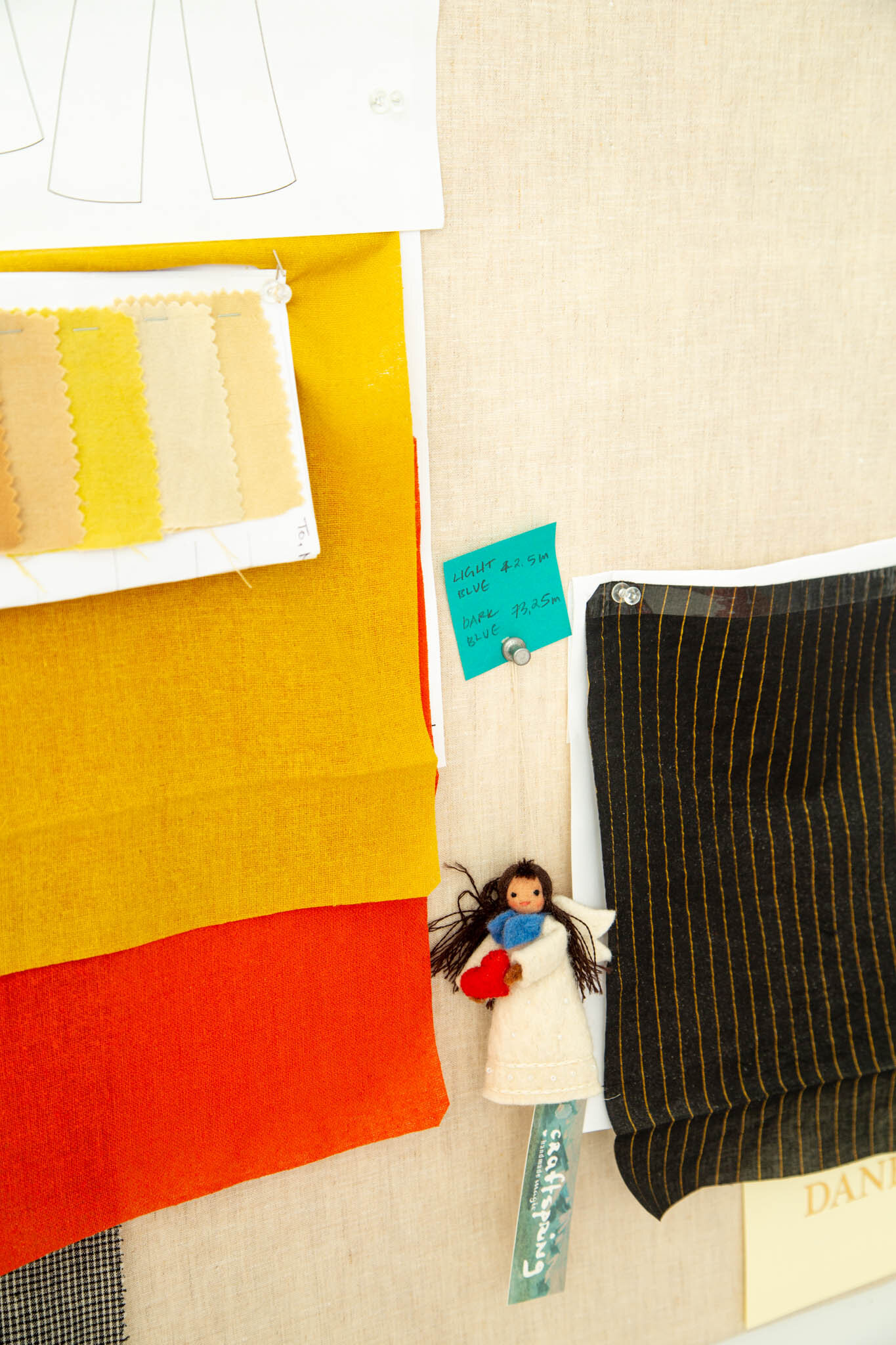Swati Argade // Bhoomki
Swati Argade, the designer behind the clothing line and Park Slope boutique Bhoomki, talks to us about her history with sustainability, how her small business is doing during this complicated point in our history, and how jewelry forges bonds between people.
Earrings: Jane Diaz Silver Triangle Dangle Hugger studs, Silver Bangles: Purchased in India, Diamond Nose Ring: Bought at her cousin’s jewelry shop in Belgaum, India, Rings: Swati and her husband designed her engagement ring and wedding band. Jumpsuit: Bhoomki Rosie straight jumpsuit.
Hi Swati! Tell me a bit about yourself. How did you get your start in fashion?
The first pieces I made were costumes for the stage. I was a dancer; my mom had a classical dance school and dance students. When I got to college I danced in various productions, and my twin sister and I toured doing Indian classical dance. We started needing costumes that were less traditional, so I created costumes that turned out to be very wearable on and off stage. And that’s what sparked it. I would go to India and buy bolts of fabric and fall in love with the textile stories that were embedded in each fabric. On some of those trips I would talk to weavers and textile makers and they would tell me that they didn’t think they could stay in business because there wasn’t a market. So that inspired me to make some work. I found some tailors at the local school in Pune to make some of my designs for me.
I brought some of those pieces back to the US with me. People started stopping me on the street and asking where I got the clothes I was wearing, and it hit me that I could make a career out of this.
So it all began with Indian classical dance. I made all of the dance costumes from saris. A lot of people are under the misconception that all Indian fabric is a sari. It’s not - a sari is a piece of fabric that comes in a couple of sizes (the most common dimension is roughly 44 inches by 6 yards) and there’s a lot you can do on the borders and with how you wrap it. My mom has this incredible collection of saris. That is actually how I learned the geography of India - she would open her trunk and pull out each of her saris and tell me where they were from.
When I came back to New York after spending many months in India, I started making clothing, doing trunk shows and wholesale. This was probably around 2004-2007. I did wholesale to stores all across the US and Europe, and to many stores in India as well. At one point it was in close to 100 stores in the US.
At the time there weren’t a lot of people doing modern silhouettes out of Indian fabrics, so it was very unique. Now it's ubiquitous. Back then, people weren’t that interested in sustainability or fair trade or in how damaging fashion can be to the planet and its people.
In the early part of 2007, I was in India sourcing leather trends in Calcutta. I was specifically interested in one type of leather – shanti nikatean – which is a beautiful painted leather style. I went to this company that was a really big supplier and said I wanted to have them make some trims for me. Their showroom was beautiful. It was filled with pieces that they made for many of the major brands that you see in big glossy magazines. I asked to see the factory, and the woman showed it to me. It was all children working. I felt so disillusioned at the time, thinking that in order to be a global fashion brand you had to work with factories like this one using child labor. So I took a break, which coincided with the global financial collapse.
I met my husband, started a family, and transitioned into working in advertising/pr. After I had my daughter I wanted to get back into fashion. I wanted to get back into working with textiles, which is my love, my passion and my career’s calling.
Tell me about Bhoomki– where the brand started, and how you now see it. When did you launch the brand, and why? When did you open the store?
Bhoomki means “of the earth.” It's kind of a made up word, that translates to of the Earth. Bhoomi means Mother Earth in Sanskrit and ki means of in Hindi.
I always wanted to have a store to be able to have conversations with people about the work that we did. I also wanted to be able to sell beautiful work by other sustainable fashion designers. I knew I could use the store as a lab for my own designs and my own work.
I knew I didn’t want the brand to be the cult of the designer. For me, fashion is such a deeply collaborative process. I didn’t want it to be about me. I wanted it to be about something much larger - the planet, and the people who make the clothing.
Necklaces: K/LLER COLLECTION, Bracelets: gifts from Swati’s mother on her wedding, Diamond Nose Ring: Bought at her cousin’s jewelry shop in Belgaum, India, Rings: Swati and her husband designed her engagement ring and wedding band. Dress: Bhoomki Shero dress. Swati made this dress to celebrate female heroes (sheros) and our enduring elegance, femininity and power as women.
Who is the kind of woman who wears Bhoomki?
I feel like we have a really solid core customer: someone who is a creative professional, well-traveled, confident and environmentally conscious. Her age range is from her late 20s to mid 60s. We are very inclusive, size focused. We want everyone to be able to find something at Bhoomki. But being in Park Slope, we do have a core base. We are now in our 8th year of business, and we’ve become one of the longest running sustainable shops in the city. We’ve become a destination because people know we have a commitment to environmental and social sustainability.
In fact we just released our sustainability report, which you can download on our website.
Editor’s Note: The sustainability report is filled with not only Bhoomki’s goals, but a number of specific actionable items that Swati is putting into place. She’s reducing now, and planning on eliminating single-use plastic bags for clothing shipped by her factory by the end of 2020. She’s swapping out all plastic hang tags with undyed cotton strings. She’s planning on increasing her use of organic cotton (currently at 20.49% of total production) to making the majority of her pieces with GOTS-certified cotton and silk by 2022.
What jewelry brands do you carry at Bhoomki?
Alchemilla, (the owner, Jen, makes beautiful beaded pieces. All of her core values are about inclusivity. She herself identifies as queer so she makes jewelry for everyone), Sandy Hyun, Jane Diaz , Sibilia, Roberta Sher, and Sierra Winter.
Many of these designers have become close friends of mine. Sandy, who is Korean American, is a very good friend. We became very close when I started carrying her work. She lives near Bhoomki and she stops in to make her deliveries; even our daughters have become good friends. I like how Bhoomki is not only a boutique but a community.
Necklaces: K/LLER COLLECTION, Bracelets: gifts from Swati’s mother on her wedding, Diamond Nose Ring: Bought at her cousin’s jewelry shop in Belgaum, India, Rings: Swati and her husband designed her engagement ring and wedding band. Dress: Bhoomki Shero dress. Swati made this dress to celebrate female heroes (sheros) and our enduring elegance, femininity and power as women.
How do you select jewelry brands to carry?
I really look for brands working with recycled materials. It’s also very important to me that they have a commitment to social and environmental sustainability. I carry brands that are owned by women and women of color. Our aesthetic is very geometric, very confident, and unique.
I’m into jewelry that is very architectural and geometric; I think of them as little art objects. Jewelry can say so much about a person, or be the anchoring pieces to any outfit.
Gretchen Jones mentioned in her interview with Multifaceted Mag that she thought it was much more simple to say you’re a sustainable brand if you work with recycled materials, but that it’s so much harder to be sustainable in every way, especially the bigger you are. Do you agree?
The bigger you get the harder it is to be in control of your supply chain. So bigger businesses have a harder time with sustainability – but companies like Patagonia and Eileen Fisher– made sustainability a core value in the beginning, so they get close. But when you’re small it’s definitely a lot easier.
For example, I was at a trade show and this woman was making everything in America, but all of the fabrics she used were viscose and rayon. I had an open conversation with her about it. She was so talented, but those fabrics are so toxic and so harmful to the planet so we couldn’t carry it at Bhoomki.
In terms of jewelry, our brands are so small that they can keep track and source all of their materials. When I’m looking at new brands, if there is even a question, or if they are stumped by anything I ask them about sustainability, then I know that they are not thinking about it, and it’s not one of their core values, and I’m not interested in carrying their lines in the shop.
How are you and your family doing during this time? As a small business owner, how has this pandemic affected you? Do you think your business will shift in any way when we come out on the other side of this?
This has without doubt been the most difficult period of my life. There is just not enough structural support for small businesses in NYC. It’s been heartbreaking to see so many dreams crushed and stores closed. I’m especially grateful for a large network of other small business owners in Brooklyn with whom I’ve commiserated at length. I’m not sure what the coming months will bring with Bhoomki, our store will reopen for sure this fall, and most likely with some new product categories and offerings. I’m kind of in a wait-and-see state with the shop. But I know Bhoomki will continue online and elsewhere.
Add to this our needed collective reckoning to address how racism permeates into every pore of our country’s foundations. I honestly don’t feel it’s been the right time to push sales during the largest civil rights protests in the history of this country, when there’s more important work to be done. We should focus instead on making lasting systemic changes in the lives of Black and indigenous Americans.
During these introspective days, I’ve vacillated constantly between grieving and gratitude, but over the past few weeks I feel like I’ve turned a corner. I feel extremely lucky to have great friends and my family to weather the storm with me, my friendships have deepened, and my marriage too! Mostly this time has also pushed me to strip bare any illusions and glamorous notions I’ve had about working in fashion and owning a fashion company, and to dig deep and ask myself what is truly important for my family and of value to my customers. I’ve pivoted to online, started working on collaborations with friends and colleagues and have become so much more intentional about what I buy and make. I’m turning to local manufacturing solutions, and finding factory owners who are empowering their employees in creative ways so they may work from home.
How do you think the pandemic will affect businesses in terms of sustainability? Have you seen it affect Bhoomki?
On the bright side, we’re driving less, we’re producing less and consuming less so greenhouse emissions haven’t been this low in decades. Fast fashion companies and massive retailers continue to file for bankruptcy left and right, so we’ve seen a bit of a reset and maybe fewer but better choices as consumers. Anyone who sells anything has seen the effect the pandemic has had on the supply chain, either it’s sold out or it’s running late and missed sales opportunities abound. Our fashion season windows are so small to sell certain goods, so if they don’t arrive in time we have to put stuff on sale immediately so it will at least sell at some profit before season-end. Little sustainable fashion brands are getting their goods late if at all since our factories are either closed or waiting to open, or the factories are waiting for fabrics to arrive.
I’ve felt encouraged by fashion companies who are finally thinking differently about the fashion calendar and all its seasons. Everything I’ve designed over the past 5 years or so has been meant to work for at least three seasons. There’s value in slowing down and designing clothes you can wear for multiple seasons. Right now I only want to make easy clothing in soft fabrics that can serve us with some style and comfort.
Please tell me about one of your favorite jewelry pieces that you have in stock. What makes it special?
I love the versatility of the Triangle Dangle Hugger Studs by Jane Diaz, and my customers do, too! You can wear them with the hugger back or without as a very simple stud. The movement and thickness of the triangle fringe provides a metallic traditional lushness, but the multitude of triangles also says geometry and modernity.
Necklace: Belonged to Swati’s husband’s great-grandmother, Earrings: part of a set her mother has had since the 1960s, Bracelets: wedding gift from her mother, Diamond Nose Ring: Bought at her cousin’s jewelry shop in Belgaum, India, Rings: Swati and her husband designed her engagement ring and wedding band. Dress: Bhoomki Lana dress.
So you’ve been designing clothing for quite some time, what about jewelry? I know you’ve modified some pieces, but I would you ever design your own jewelry brand?
Yes! I’ve become interested in designing jewelry lately, and Sandy has taught me a lot about how to put together interesting pieces. So far, people have asked me to freelance doing jewelry buying and merchandising for them.
But, yes, in fact, I’ve made some pieces with family members in India. There are jewelers on my mom’s side of the family. The business has been in the same family for generations, and I’ve done some pieces with them, mostly bangles and some necklaces. Also, with many of my jewelry designers, a lot of them do custom work for me. I don’t put anything in the store that I wouldn’t wear, so a lot of my relationships with jewelry designers are partnerships and collaborations.
In the past, I was very focused on designing clothes, but when I opened the store eight years ago I realized I needed to have jewelry and accessories in stock too. Jewelry has that feel of being a central part of a person’s look, and it's also so personal because people pass on jewelry for generations. So it's become one of my favorite things in the store.
If you were to launch your own line, what materials would you use?
I've gotten really interested in uncut stones. I’ve found these really beautiful pieces of turquoise that I want to use. We’re partnering with a lot of artisans in Jaipur (which people refer to as gem city). A lot of jewelry designers go there to buy stones. I like how there is a certain rawness to some of these pieces gives it an earthy esthetic. I’m also looking for elegance as well. I think that’s what makes us unique earthy, rawness and elegance balance.
I'm also into crystals. I found out that black tourmaline for example is to resist negativity, like an evil eye, rose quartz is great for your heart chakra, I’m interested in what various crystals mean. Everything we carry I try to have meaning behind. That would be the same with any jewelry I would make.
I always say “I’m not a hippie, I'm a hindu.” :)
Necklace: This necklace belonged to Swati’s husband’s great-grandmother, and his grandmother left it to him when she passed. His great-grandmother and grandmother escaped the Nazis and hid in Italy where they eventually settled for a few decades. It’s made of pure 14k gold and it was likely made in the early part of the 20th century by Italian artisans.
Tell me about the toe ring you converted into a ring you wear on your hand.
The shop I was telling you about that's been in my mother’s sister’s family for generations is in a city called Belgaum – it's not too far from Goa. And in the areas around Belgaum there are places that are very very famous for their silver production, so a lot of villagers in that area would come in and trade pieces from their families for pieces they wanted from the shop. So that toe ring was a village woman’s toe ring. And so we bought two of them, one for me and one for my first cousin who is no longer on the planet. She was probably one of the most important people to me in my life, so that piece is so important to me. I think about her every day and every time I wear it.
I remember when we went there were these vats of silver jewelry and we were digging through these bins and found those toe rings. I completely forgot about it for a while.
I wish I knew who the villager was who originally made it. We don’t know how long those pieces were sitting in the studio, they could have been sitting there for decades. People are so obsessed with gold so they thought I was a crazy American going through these vats of silver. My family would laugh at me for wearing silver instead of gold. At the time, villagers wanted to trade silver for gold. But the workmanship in those silver beads is so hard to find these days - it’s a very specific process.
A lot of people won't mix gold and silver like they won't wear black and navy and I'm like, live a little!
How would you describe your personal style, especially when it comes to jewelry?
I love pieces that have a measured balance between heritage and the future. I love to buy and wear jewelry that exists in this sweet space where time and craft begin and a farfetched fantastic future ends. I love raw stone in geometric settings for example, and bold structured pieces that speak more about materials than embellished and ornate surface ornamentation that often marks Indian jewelry styles. It’s beautiful, it’s just not me. I gravitate to chunkier vintage pieces from the first half of the 20th century when it comes to Indian jewelry.
Earrings: Jane Diaz Silver Triangle Dangle Hugger studs, Silver Bangles: Purchased in India, Diamond Nose Ring: Bought at her cousin’s jewelry shop in Belgaum, India, Rings: Swati and her husband designed her engagement ring and wedding band. The ring on Swati’s right hand was a toe ring Swati purchased in India, and then converted, Necklace: Onyx and silver collar from Amrapali,
You bought that gorgeous black necklace for yourself as a gift, but I can't remember the story. Could you please remind me?
One of my favorite places to shop for jewelry is Amrapali in Jaipur, Rajasthan. Some years ago I was in India and encountered a gorgeous collar of the most perfectly smooth black onyx teardrops. In between the onyx alternate slivers of hand cast silver beads, and there’s this perfect heart-shaped clasp. Rarely do I make such an impulse purchase, but it was a few days before my wedding anniversary. I took a picture of me in it and thanked my husband for it on instagram for the anniversary present. He thought it was funny and, besides, he wouldn’t dare buy me jewelry.
Swati and her husband designed these rings. They represent each of their roots and are an homage to New York City, their favorite place in the world and where they met.
Your wedding ring is so unique! Please tell me the story behind it.
My wedding ring is one of the most important things to me. My husband and I designed it together. I had been in love with this South Indian wedding ring; it is generally made in gold. I wanted to have something that spoke to my Indian heritage, but I also wanted to have a wedding band and diamonds and I wanted them to nest. These pieces are almost spooning.
My husband, Alec, is Italian and Jewish. The diamond district is filled with Jews and Indians. Every Indian woman I know in the city has a diamond guy in the diamond district. My diamond guy told me he had a ring maker for me from Naples. We did it all in NYC where we fell in love and met, and it was a great representation of who we are – encompassing New York, India and Italy.
It's not typical in India to wear an engagement ring. They have a wedding ring and a necklace called a mangal sutra that they wear, and that’s more typical. But we wanted to have a more traditional ring as worn by women here. Because even both of us come from an immigrant background, we are both born and raised in America. Who Alec and I are together.
How do you think jewelry forges connections between people?
Jewelry is so personal, it carries so much weight and history. I have so much jewelry. I'm constantly telling my daughter that it's all going to be hers and I tell her all the stories about each piece.
I love that people come to Bhoomki and they purchase a piece of jewelry that has a story that they can take away, about the piece itself, as well as about the store being a place to find sustainable fashion.
Necklace: Belonged to Swati’s husband’s great-grandmother, Earrings: part of a set her mother has had since the 1960s, Bracelets: wedding gift from her mother, Diamond Nose Ring: Bought at her cousin’s jewelry shop in Belgaum, India, Rings: Swati and her husband designed her engagement ring and wedding band. Dress: Bhoomki Lana dress.
Thank you, Swati!












